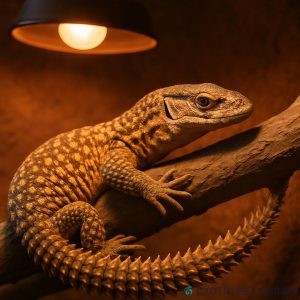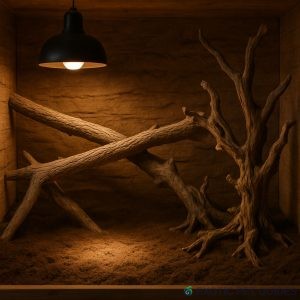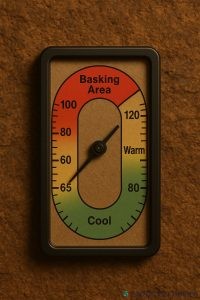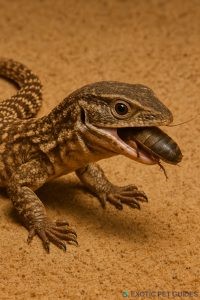Ackie Monitors (Varanus acanthurus), also known as spiny-tailed monitors, are intelligent, active, and surprisingly manageable lizards. Native to arid regions of Australia, they’re often recommended as a “beginner monitor” due to their moderate size and generally calm demeanor. If you’re considering your first monitor lizard, the Ackie might be your perfect match.
🦎 What Makes Ackie Monitors Ideal for Beginners?
- Size: Ackies grow to about 16–28 inches (40–70 cm) including the tail — much smaller than most monitors.
- Temperament: Generally docile and curious once accustomed to human presence.
- Low Risk: Unlike large monitors, they’re less likely to cause injury if mishandled.
- Lifespan: 15–20 years with proper care — a long-term companion.
🏡 Enclosure Setup: Provide Space and Depth
Minimum Size: 4x2x2 ft (120x60x60 cm) for juveniles; 6x3x3 ft (180x90x90 cm) or larger for adults.
Key Enclosure Needs:
- Substrate: Deep, diggable substrate (10–12 inches) like a mix of topsoil, sand, and clay.
- Lighting: Strong UVB lighting (T5 HO preferred) + basking bulb (up to 120°F/49°C basking spot).
- Humidity: Maintain 40–60%, but provide a humid hide to support shedding.
- Hides & Enrichment: Include cork bark, rocks, tunnels, and climbable structures.
🌡️ Temperature and Lighting Gradient
- Basking Spot: 115–130°F (46–54°C)
- Cool End: 75–85°F (24–29°C)
- Night Drop: Down to 70–75°F (21–24°C)
Lighting Tip: Use a 12-hour light/dark cycle. Ackies are diurnal and love to bask.
🐛 What Do Ackies Eat?
Ackies are insectivores, though some may accept occasional pinkies or scrambled eggs.
- Staples: Crickets, dubia roaches, mealworms, superworms
- Supplements: Dust insects with calcium + D3 3x/week and multivitamins 1x/week
- Feeding Frequency: Juveniles daily; adults 2–3x per week
✋ Handling and Behavior
- Start slow: Let your Ackie acclimate first. Offer food from tongs.
- Handle gently: Slide hand under its body and support tail base.
- Signs of Stress: Hiding constantly, hissing, tail-whipping.
With time and patience, Ackies often become tolerant of short handling sessions and may even approach you voluntarily.
✅ Summary Checklist
| Care Aspect | Recommendation |
|---|---|
| Enclosure Size | 6x3x3 ft (180x90x90 cm) minimum for adults |
| Basking Temp | 115–130°F (46–54°C) |
| UVB Lighting | High output T5 10.0 UVB |
| Substrate Depth | 10–12 inches (diggable mix) |
| Diet | Insects, occasional treats, supplements |
| Handling | Gentle, gradual, 2–3 times a week |
🧠 Final Thoughts
Ackie Monitors are one of the most rewarding monitor species for reptile keepers. Their small size (for monitors), natural curiosity, and relative ease of care make them a perfect step up from geckos or bearded dragons — without jumping into the chaos of a full-sized monitor.




